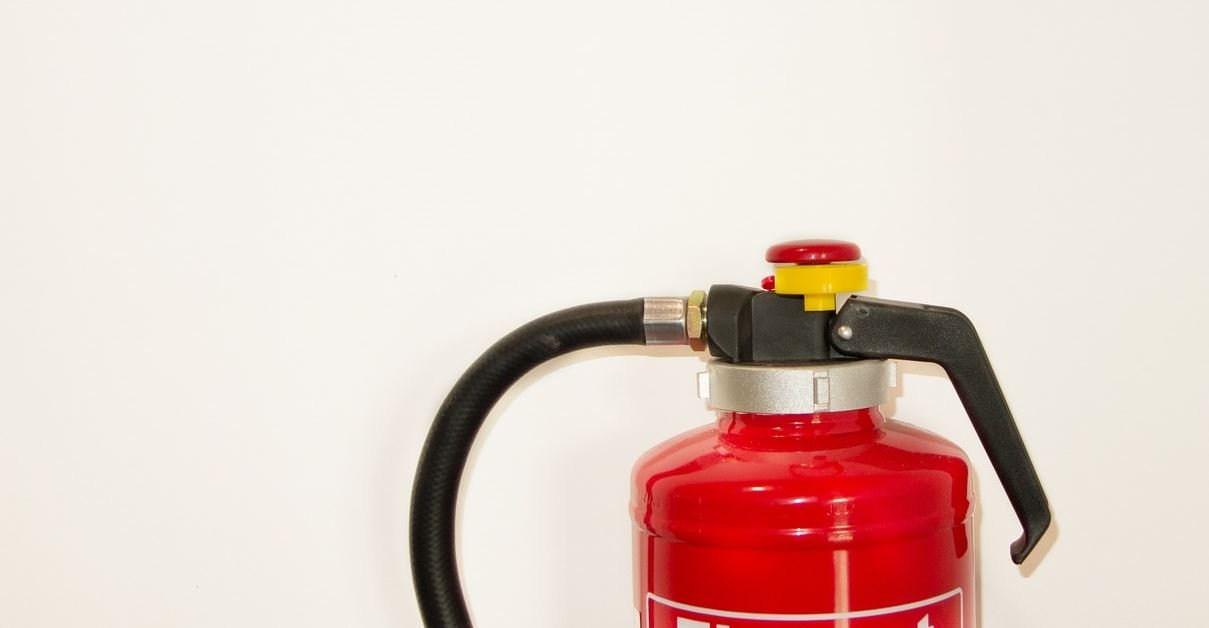There are nearly 20,000 commercial fires in the UK each year, demonstrating the importance of taking fire prevention measures in business premises.
So, what are the legal obligations of building or business owners regarding fire extinguishers?
All fire safety legislation in England and Wales for non-domestic premises is covered by the Regulatory Reform (Fire Safety) Order 2005 (RRO), which states that appropriate fire-fighting equipment, including portable fire extinguishers, must be provided where there is any risk of fire.
The RRO states that business owners and managers as designated Responsible Persons (RP) are responsible for carrying out a fire safety risk assessment and implementing and maintaining a fire management plan.
Since the law is not prescriptive in many areas, the fire safety risk assessment is crucial, and applies to all businesses, however small. RPs should ensure staff are trained in extinguisher location and correct use, and hold fire drills and evacuation procedures. Failure to protect staff by providing appropriate equipment could lead to prosecution and refusal of insurance pay-outs, apart from injury and loss of life.
The provision and maintenance of fire extinguishers is also covered by BS5306, which gives guidelines as to which extinguishers to use where and on what type of fire, but also allows an element of choice.
Fire and extinguisher categories
Currently, materials present in the area to be protected from fire in the UK can be divided into 6 categories of fire involving different substances:
- Class A, combustible carbon-based solids eg paper, wood or textiles
- Class B, flammable liquids eg paraffin, petrol, diesel or oil (but not cooking oil)
- Class C, flammable gases, eg butane, propane or methane
- Class D, burning metals, eg aluminium, lithium or magnesium
- Fires caused by electrical equipment (indicated by an electric spark symbol and not the letter E)
- Class F, fats and cooking oils.
It is very important that the right type for the risk, the business and the location are supplied. The following types of extinguishers can be used to quench the various types of fire:
- Class A – water, water mist, foam, dry powder, wet chemical
- Class B – water mist, foam, dry powder, CO2, some wet chemical
- Class C – water mist, dry powder
- Class D – specialist dry powder
- Electrical – some water mist, some foam, CO2
- Class F – water mist, wet chemical
Read more about Fire extinguisher types: How to choose the right class.
How many fire extinguishers do I need?
The regulations state that a minimum of two Class A fire extinguishers on every floor of a building are needed, unless the premises are very small, in which case one may be acceptable. Three- or six-litre foam, or nine-litre water, are the most frequently found types, although others are likely to be needed as well, most commonly CO2 extinguishers for electrical fires.
All premises with electrical equipment (which covers most premises) must have at least 2kg CO2 extinguishers, 5kg if there is 415-Volt rated equipment.
The number required depends on the size of the area to be protected and whether the business is classed as low or high risk. As a basic rule of thumb, the floor area in square metres should be divided by 200 and rounded up to calculate how many nine-litre water or equivalent extinguishers are necessary.
If there is a sprinkler or automatic suppression system in place, fewer fire extinguishers may be required.
Where to put them
Fire extinguishers must be accessible and visible. Water-based and CO2 fire extinguishers should be located by exits and fire alarm call-points to encourage people to move away from the fire.
The 30-metre rule is useful – in a low risk workplace an employee should be within 30 metres of an appropriate extinguisher on any given level of the premises, meaning that the devices can be sited 60m apart.
Specialist extinguishers, such as dry powder for Class C fires in areas such as boiler rooms and wet chemical extinguishers for kitchens (Class F), should be positioned within easy reach of, but not too near, the specific fire hazard, eg the boiler or the deep fat fryer. CO2 extinguishers should be placed within server or plant rooms.
Extinguishers should either be fixed by brackets to the wall, or, if very heavy, attached to a rigid floor stand to discourage people from moving them. Heavier extinguishers should be fixed with the handle at a height of about 1 metre.
If they are not totally obvious, extinguishers must be clearly signposted with ID signs fixed to the stand or wall and directional arrows if necessary. ID signs explain the type of extinguisher and how and when to use them.
If they need to be sited outside, water and foam extinguishers can be purchased that contain an anti-freezing agent.
Commissioning
Fire extinguishers must be commissioned on site by a competent person – usually someone with the BAFE fire extinguisher or equivalent qualification from a third-party-certified fire protection company. This involves a thorough check to ensure they are fit for purpose. A certificate will be issued to prove their compliance with the regulations.
Servicing and maintenance
Extinguishers must be maintained in good working order. The RP should carry out monthly visual checks, but they must be serviced annually by a competent person. A basic service should include checking it is in date, hasn’t been tampered with, is in good working order, with correct weight and pressure and has the correct signage and positioning.
Advice should be given on refilling/replacement or any additional extinguishers needed and the service recorded on the service label on the side.
UK fire extinguisher regulations recommend that extinguishers should be replaced or given an extended service/overhaul every 5 years. CO2 extinguishers should be replaced every 10 years, unless they are damaged or have been discharged. No extinguisher must ever be more than 20 years old.
It is also a legal requirement to keep a permanent record of all servicing, maintenance and inspections of fire extinguishers.
Connect with the fire safety community online 1-30 June
Connect 2021 is your first major opportunity to come together with the fire safety community online from 1-30 June!
FIREX Connect, the month-long online event, will give attendees the opportunity to make up for lost time by browsing fire safety solutions, connecting with suppliers and getting up-to-date on the latest legislation from the comfort of your home.



“Regulatory Reform (Fire Safety) Order 2005 (RRO), which states that appropriate fire-fighting equipment, including portable fire extinguishers, must be provided where there is any risk of fire.” Is not correct.
The words “where necessary” are important.
I think we should have tougher laws on this matter and wonder if Dame Judith Hackitt might actually spot this weakness.
It is very important to protect the nature from fire so that we use the fire fighting equipment that provides from our site i.e starflame
HI i live on a park home site with 34 homes in total. On site we have 4 containers with 2 fire extinguishers in them at 4 outside locations. These bottles are service yearly. I found one alarm not working and after speaking to site owner I found out they do not inspect any extinguishers monthly.
Question should extinguishers be checked monthly and should site have a fire marshall.
That is interesting that fire equipment should be maintained. Then they can stay in good working order. That is something I would want to have done sometime soon. https://www.northernfire.com.au/services
I have a small gym business , have all the necessary fire extinguishers in place but feel it is unnecessary to test them weekly but is it the law to do so as I am not sure
Are we required by law to inspect the fire extinguishers each month and keep records?
Monthly checks are required with records should be carried out by RP… yearly safety checks have to be carried out by an accredited engineer and signed off and dated…
i have reported that there is a fire extinguisher cupboard being blocked by a fridge what regulations is this breaking?
Can a fire extinguisher legally be used to keep a door open?
What is the height is required from hydrant system
It’s good to know that you should make your fire extinguisher visible by placing it near your exits. When my uncle opens a business, he wants to make sure that his employees are safe if there is ever a fire in the office, it is important to him that everyone knows where the extinguisher will be. I’ll let him know that placing it near the exits would allow anyone to access it if necessary.
What is the legal requirement that empowers recharging of DCP in every 6 months and CO2 in every 12 months
Hi my brother in intensive care from a blast from fire extingher is any body liable for a very old out of date one
[…] service should be carried out once a year by a competent person to ensure that your extinguishers are up to standard. This service includes checking for corrosion, […]
Hi, can i ask for an advise? We have little wooden huts, 2.3×2.3 Six of them next to each other. Would we need Class A in every little hut? Thank you
What type of study design is this??
‘The regulations state that a minimum of two Class A fire extinguishers on every floor of a building are needed, unless the premises are very small, in which case one may be acceptable’ – what regulations is this quote from? Here is the regulation from the RFSO: Where necessary (whether due to the features of the premises, the activity carried on there, any hazard present or any other relevant circumstances) in order to safeguard the safety of relevant persons, the responsible person must ensure that— (a) the premises are, to the extent that it is appropriate, equipped with appropriate fire-fighting… Read more »
The RFSO –
(b) any non-automatic fire-fighting equipment so provided is easily accessible, simple to use and indicated by signs.
Seriously?
BS5306 part 8 states 2A class with an aggregate rating of 26A for not more than 400sqm, there is no dispensation for smaller areas, that said it is an ACOP not a regulation.
Hi Constance. I have someone here still suffering 20 months later after a work fire extinguisher went off whilst he was driving. Had collpsed lungs and on going health issues to date. I hope your brother is recovering. Could you please get in contact as trying to take employer on legally. Email would be great
is there any part that states that all foam extinguishers are now to be capable of putting out electrical fires?